Invitation
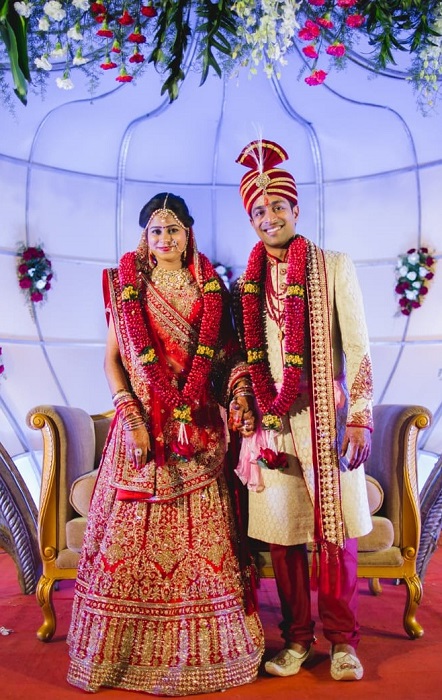
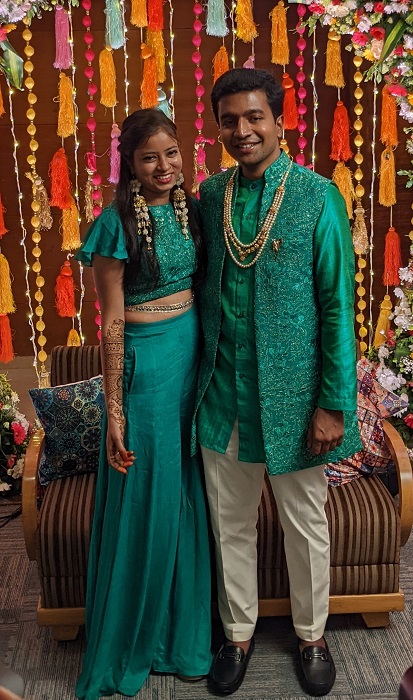
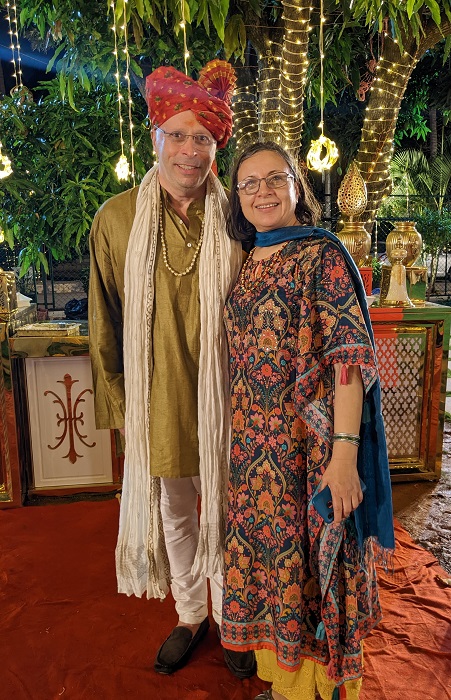
Dress Code
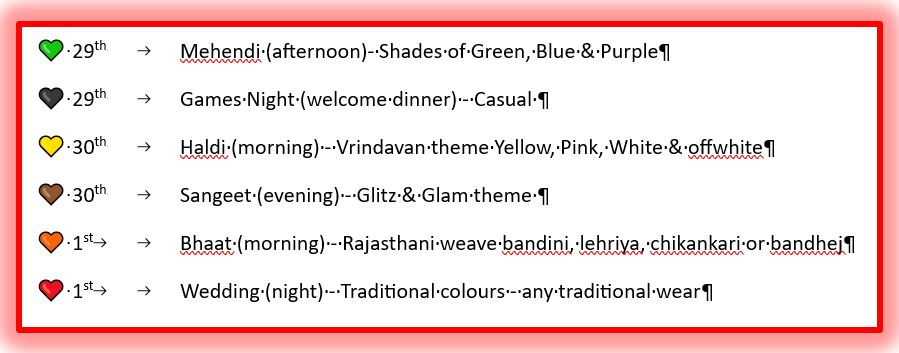
As part of the wedding invitation, we were given a dress code which was partly impressive and exciting and partly anxiety inducing especially as our smart clothes had been put into storage. We were just going to have to re-buy beautiful clothes once we arrived. Oh dear!
Mehendi
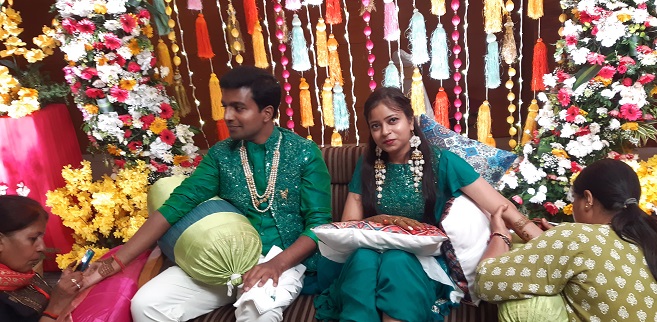
The Mehendi ritual of painting henna on the feet and hands of the married couple to bring them prosperity is a tradition going back centuries. Henna was traditionally applied to the bride and groom in separate houses but Sakshi and Nikhil had their arms decorated together.
The artists are brilliant in their skill and creativity. Traditional patterns are interwoven with original ones. Often, the initials of the new couple are hidden within the patterns painted onto their arms for them to find on each other.
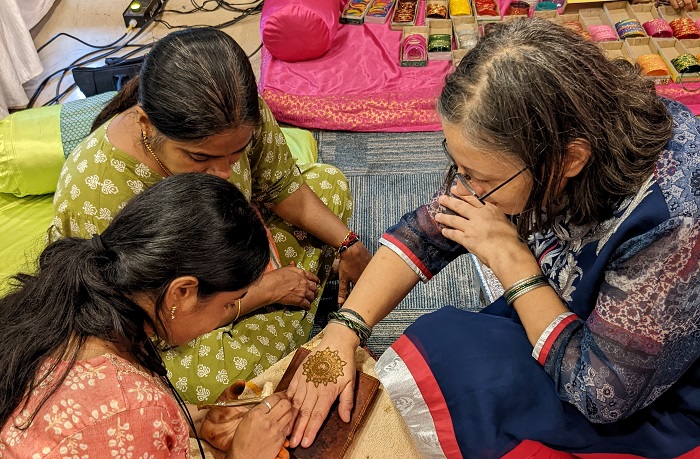
Close family were also treated to the honour. We were treated throughout the wedding as close family. We could have had a larger, more intricate motif on each side of both hands but on this occasion, we preferred something small on just one hand.
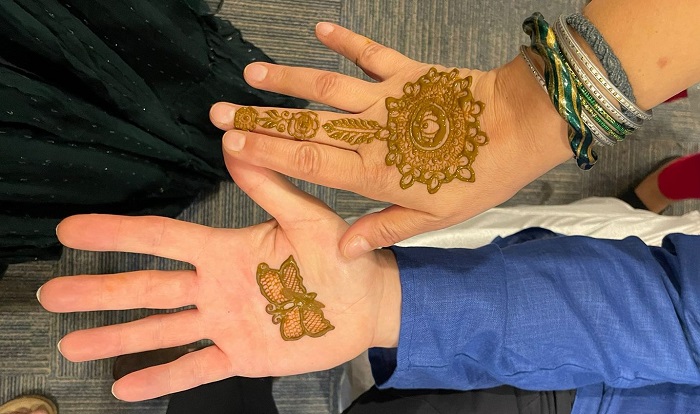
The result! The experience was gentle and beautiful. The henna took about an hour to dry and remained for two weeks. We were told that the darker the art becomes, the more beloved you are! Guests can request a picture or pattern. Jeff wanted a butterfly. Sylvie gave the Mehendi artist free rein.
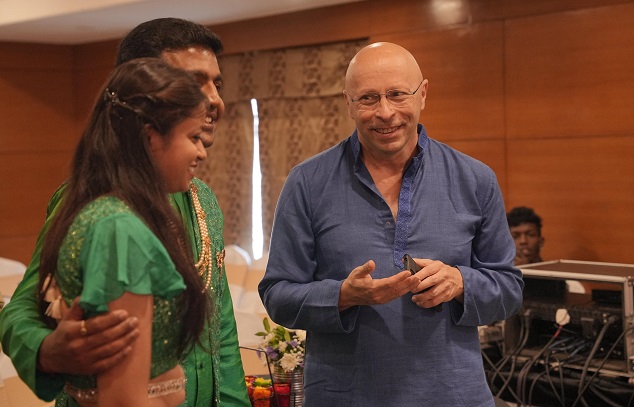
As we were the only non Indian at the party, lots of people including the young couple asked whether we would have Mehendi, and expressed great satisfaction when we showed them our designs.
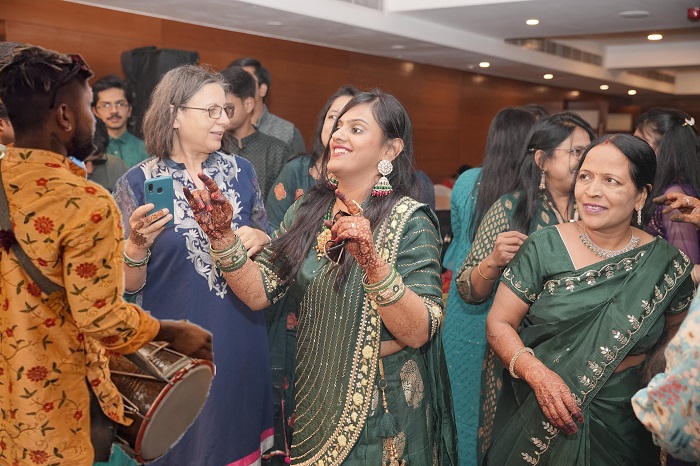
The Mehendi party was celebrated, of course, with some jubilant drumming and dancing.
Accompanying every ritual was a huge amount of delicious food from chefs and bakers. It was a joy to see their culinary arts in full flow. We were particularly interested in seeing Naan being prepared and baked in the tandoor.
Haldi
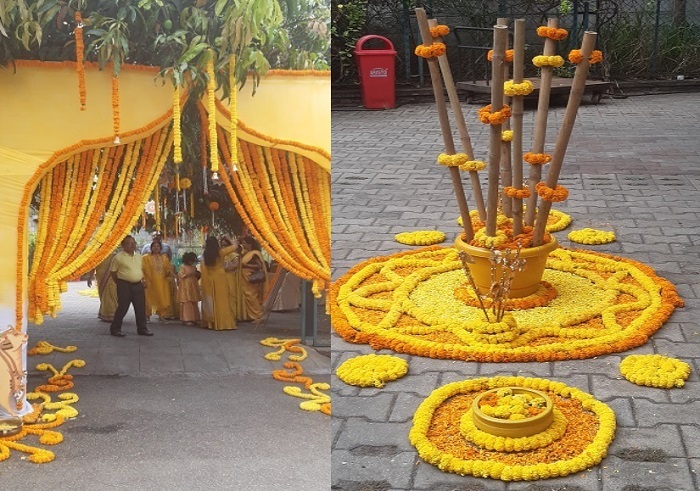
Overnight, the wedding hotel’s grounds were transformed with hundreds of flower garlands into a fairy-tale set for the Haldi ceremony. The purpose of the ceremony is to bless the married couple with good health and prosperity and beautify their skin while relaxing their bodies and souls before the wedding.
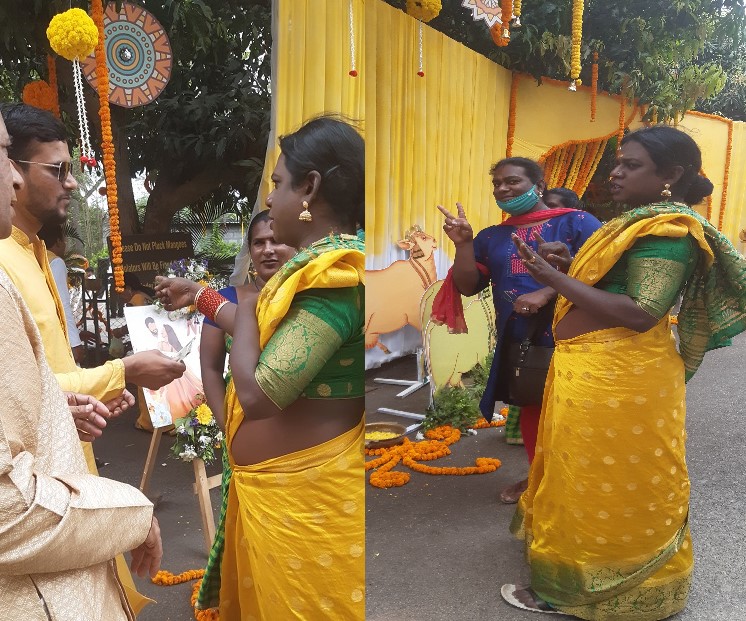
India recognises a third gender, the Hijra. Made up of eunuchs and transgenders, they are often ostracised yet play an essential role, being imbued with the power to bless or curse. This is taken seriously. Hijras turning up at functions or at any moment in life, sometimes to sing or dance, is considered a good omen as long as they also leave happy, so the family were happy to make a donation for their blessings.
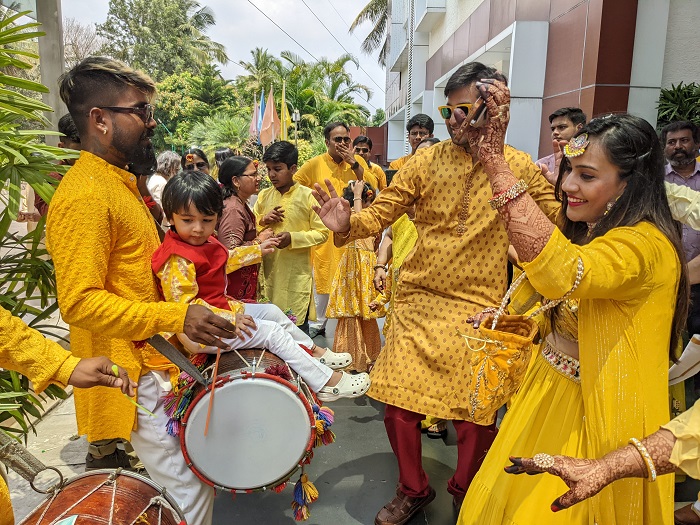
There is no Indian wedding ritual without an element of music. If there is music, there will be dancing. This is the first ceremony attended by the family at large. Dancing together is a lovely way to meet up happily together after being apart. It preceded the Haldi ceremony.
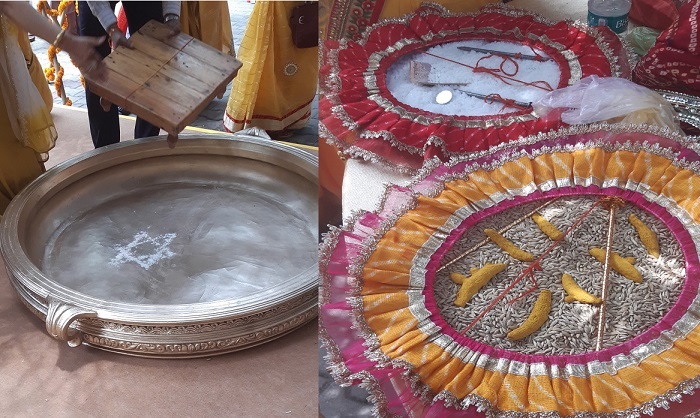
The Haldi ceremony begins. Two large ornate metal shallow basins are cleansed and consecrated with an auspicious symbol (here the bride’s symbol), ready to receive the low stool on which the bride or groom will sit. Meanwhile, the senior ladies of each family prepare a ceremonial dish laden with symbols.
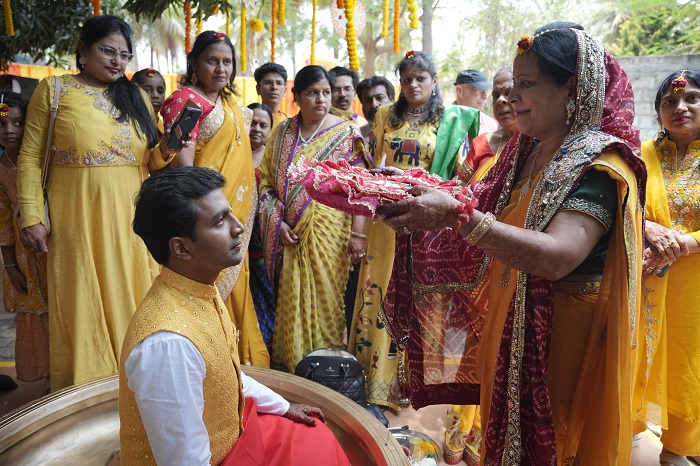
Each dish contains the symbols of the traditional functions of the bride and groom (salt and metal nails- protector and provider for the groom; turmeric and rice – mother and homemaker for the bride). The dish is then circled by each mother over the head of her child. Often, the Haldi happens separately for the bride and groom, here both were united on the same stage.
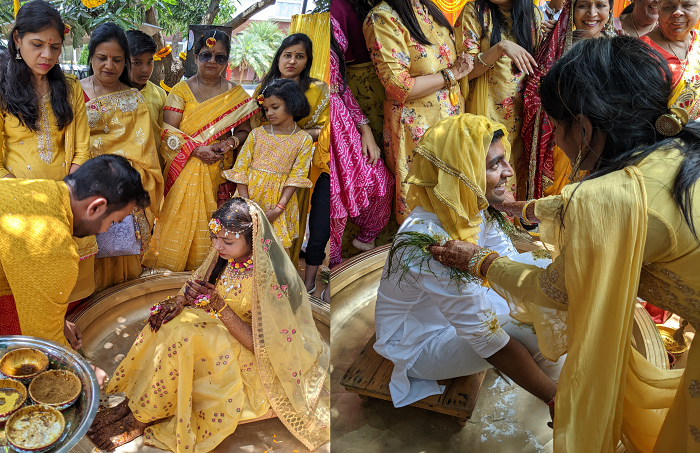
Starting with the parents, each family member then dips two small bunches of grass into a paste made of turmeric (haldi), curd, powdered sandalwood, gram flour and mustard oil, and a small quantity is tapped gently for the bride, more playfully and forcefully for the groom, on the feet, shoulders, cheeks and hair.
Once every member of the family has offered the haldi blessing, a veil is lowered onto the head (here the groom’s) who is then showered with marigold petals. The colour yellow is auspicious. It is associated with new beginnings, peace and happiness.

The Haldi over for the young couple, they are led separately to a ceremonial bath. There are six functions to the use of turmeric in this ritual: it signifies purity, fertility and good health; it makes the skin glow; it relaxes the mind; it purifies body and soul; it reflects health and prosperity; it serves as a medium for blessings.
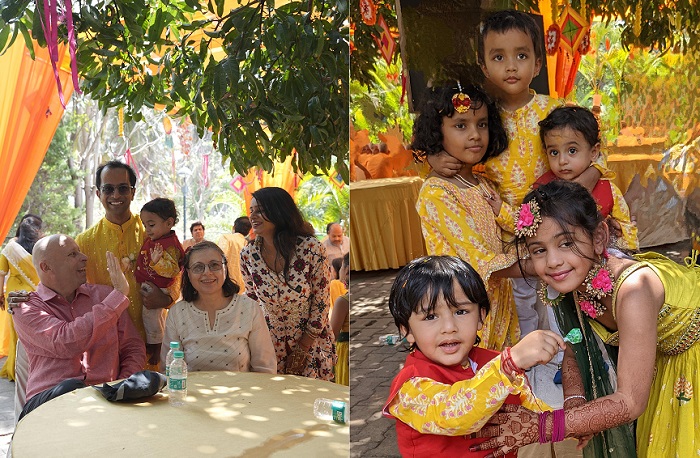
“It takes a village to raise a child”. Children are fully involved in each and every ritual. When the family at large gets together, there is always someone to look after the smallest members of the family, from older cousins to willing aunties and uncles, including co-opted ones!
Tilak
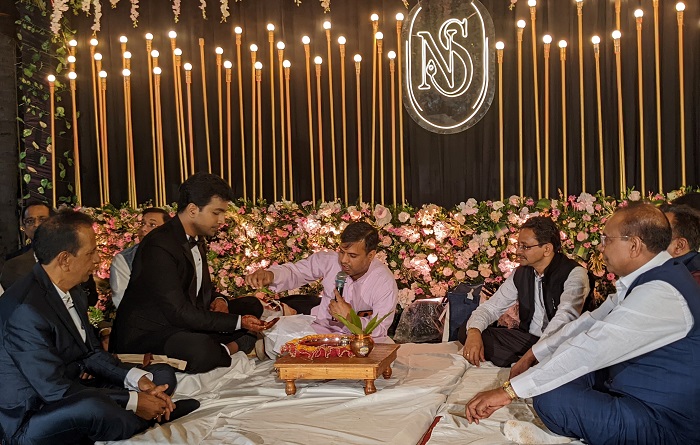
In the Tilak ceremony, the bride’s father welcomes the groom-to-be in his family. A sacred space is set with a priest leading the process in which both fathers exchange ritual gifts. The tilak, or red paste marking, is then placed on the groom’s forehead by his future father in law, as a call to be a loving husband and a good father.
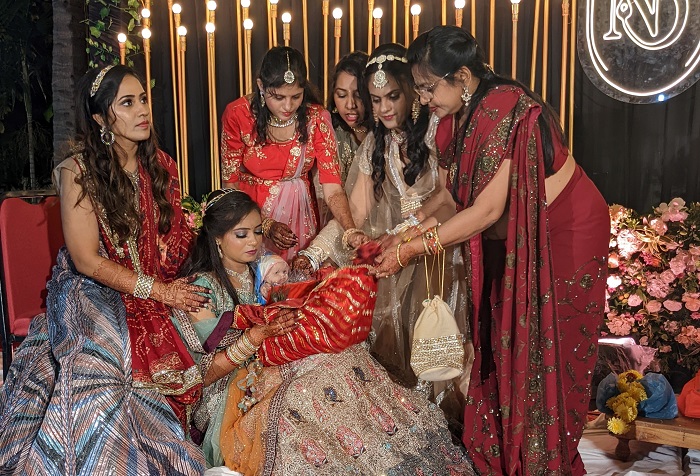
After this welcoming of the groom, the younger female members of the groom’s family welcome the bride-to-be as a new sister. It is time to shower her with presents of jewellery and precious stuff laid in a red ceremonial stole on her lap, like the “corbeille” in French weddings.
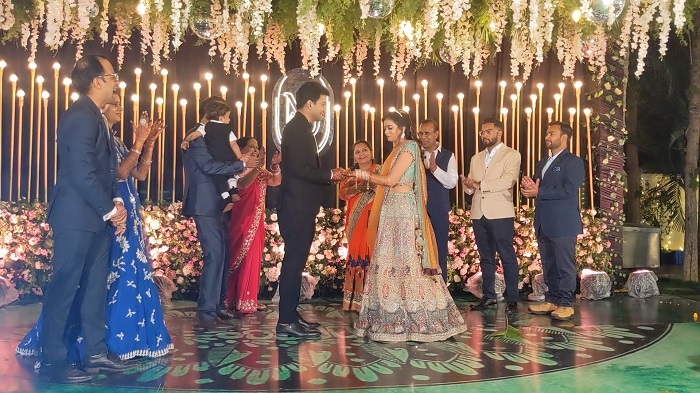
It is now time for the exchange of rings, which marks the couple’s formal engagement, taking place just one day before the wedding. Only the closest family i.e. both sets of parents brothers and sisters on both sides are involved. Meanwhile, the rest of the guests are getting ready for Sangeet.
Sangeet
Meaning “sung together” in Sanskrit, Sangeet is about the celebration, through songs, dances and skits, of the forthcoming marriage. It included very cool dance performances like this one which made us feel we were living inside a Bollywood movie.
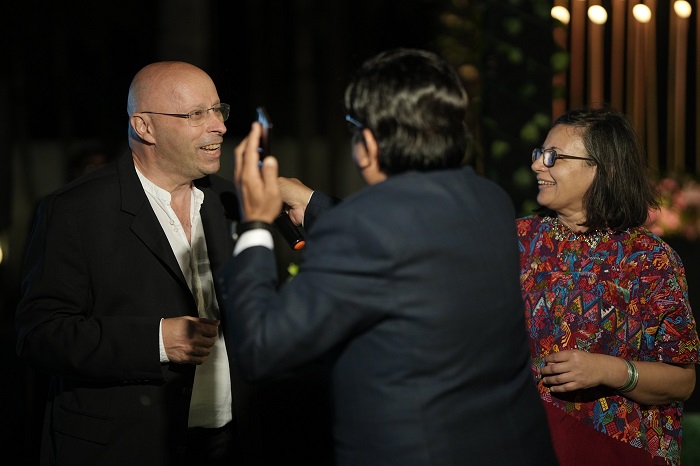
We had our own impromptu dance too and we were even asked to sing a song in Hindi. Very funny but far too embarrassing to show here! The singing and dancing went on until late with many performances taking place.
Bhaat
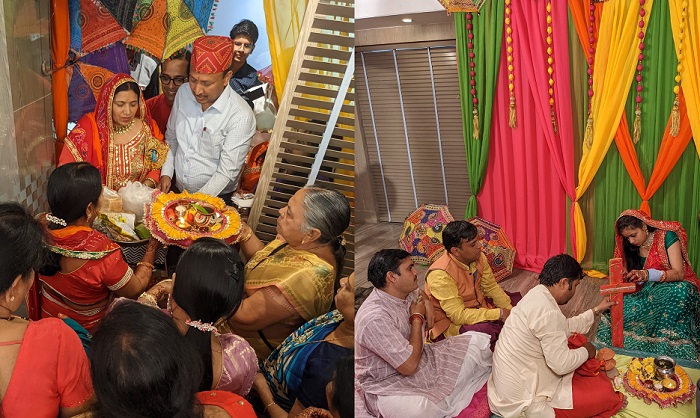
At the invitation by each spouse’s mother to her eldest brother (Mamma ji) to attend Bhaat (a rice and lentil dish), they arrive bearing gifts for the bride and were welcomed ceremonially by their sisters with sweet water and sweetmeats. Ringlets were placed on the bride’s toes and and anklets on her ankles.
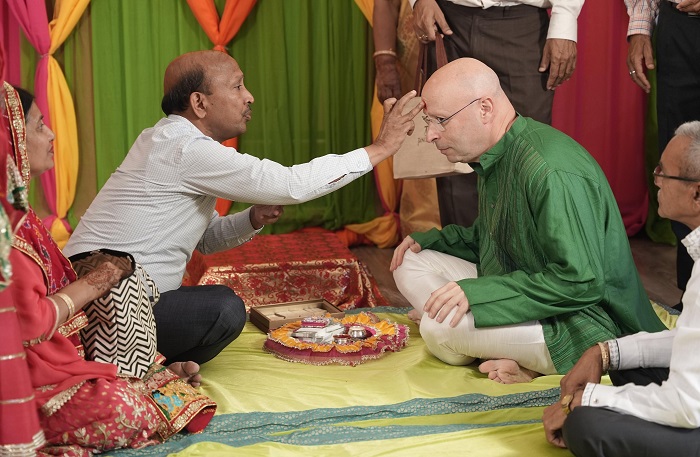
Blessings, teekas (red paste markings on the forehead) and gifts were also generously bestowed upon close family members. A traditional arranged Hindu wedding engages much more than a young couple: it marks the official alliance of two families.
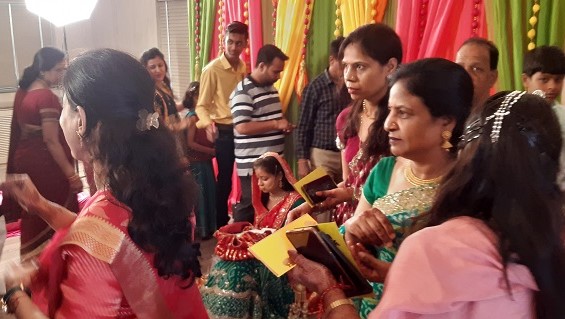
Attendants of the Bhaat receive an envelope containing a bank note from the maternal uncle and aunt of the bride. Later for the Gauri Puja, everyone circles the bride seven times to worship her as goddess Gauri, while the gift envelopes are dropped onto her lap. This is not part of her dowry but her own property to use as she pleases.
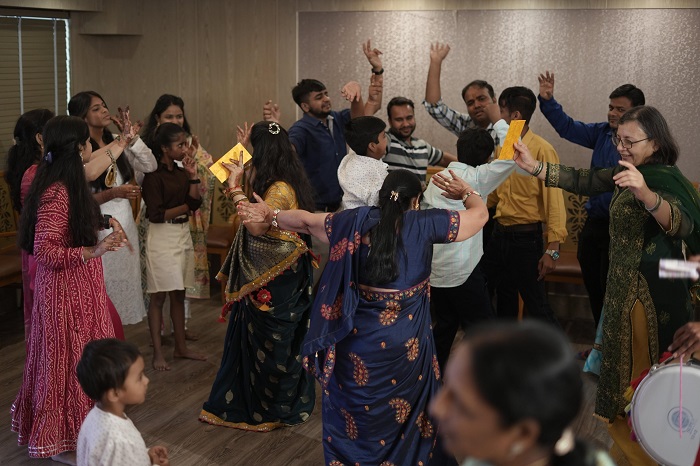
While dancing away in the seven circles, we only realised after the event that we should have dropped our envelopes onto the bride’s lap… So, after the wedding, the content of the envelopes we received was donated to Care India: a charity that provides girls and women with education and hygiene products.
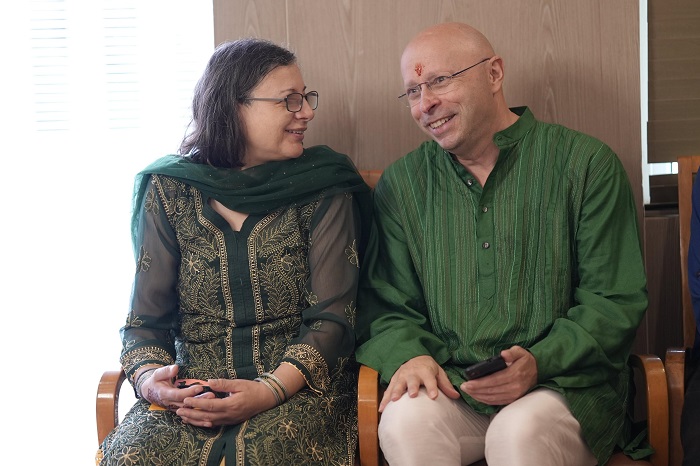
We felt so privileged to be admitted into all the rituals and be welcomed so hospitably by these two lovely families! And of course, we were so pleased with ourselves in our Indian clothing!
Tel Baan
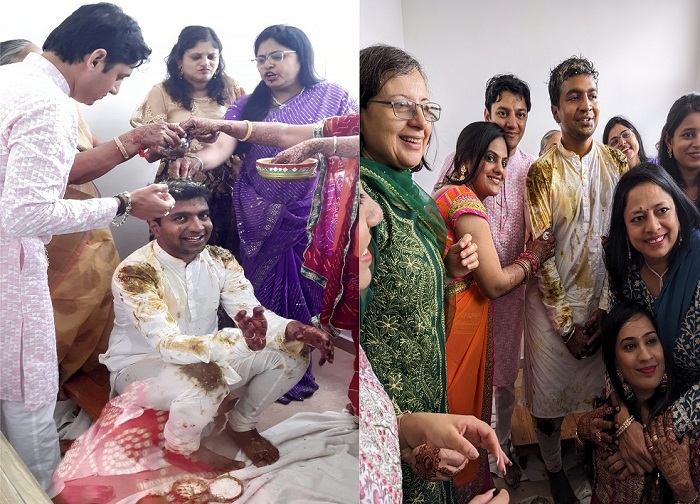
Some rituals like the Tel Baan are held separately by each family. A ceremony involving a paste similar to the one at Haldi is this time massaged into the groom’s skin and hair for beautification.
Baarat
That same evening, before the wedding reception started, all the close male family members were dressed in turbans. The fabric arrives starched and pleated and it takes all the speed and dexterity of the specialist turban dresser to manage to cover the head of some thirty or more men and boys on time to start the procession.
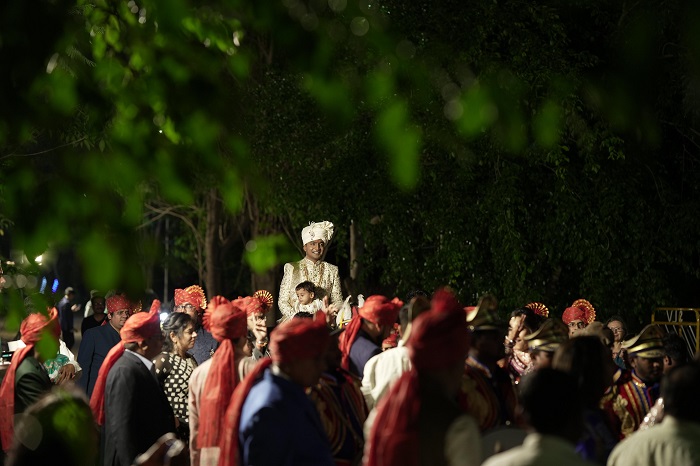
The Baarat (groom’s procession) soon follows. The groom, dressed as a prince, parades into the wedding function on a white horse, led by drummers and a brass band and surrounded by family members and friends all dancing joyously.
It is a moment of unbridled joy and loving cacophony. The horse , who had seen it all before, didn’t show any nervousness… neither did the groom, even though it was his first time on a horse…but the noise level was insane! The procession proceeded for a quarter of a mile with all the neighbours on their doorstep to watch it.
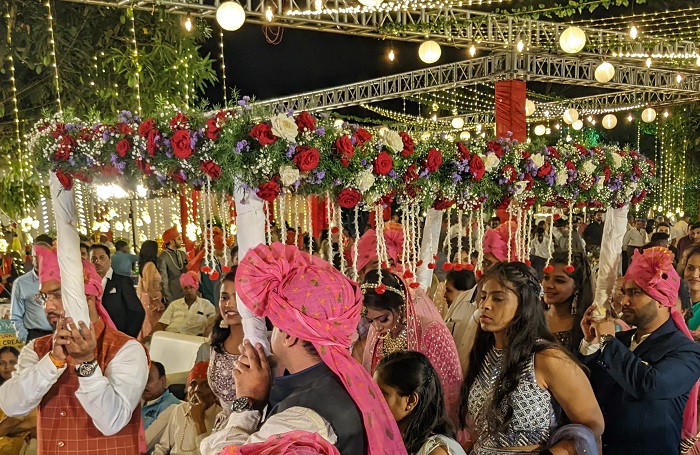
In the meantime, most members of the bride’s family are waiting at the wedding function, ready to welcome the groom and his party with teekas and a shower of rice. Later, under a canopy, the bride has her own procession into the wedding function, accompanied by close family members.
Wedding Reception
The bride and groom place beautifully ornate fresh flower garlands (fragrant roses and jasmin buds) around one another and in doing so jokingly give a sign as to how independent they will be in their marriage through resisting the garland.
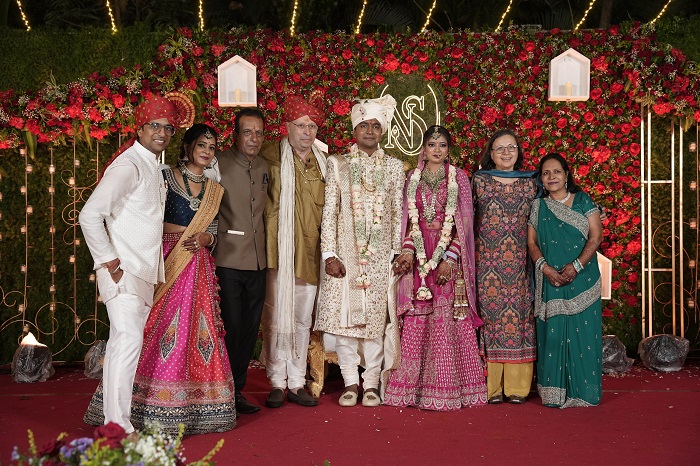
While an elaborate buffet and entertainment charm the thousand guests present, the wedding reception means hard work for the young couple, the brother and sister in law and the parents of the groom who as hosts, have to stand and smile while each guest or group of guests stream in front of them for a personal photo.
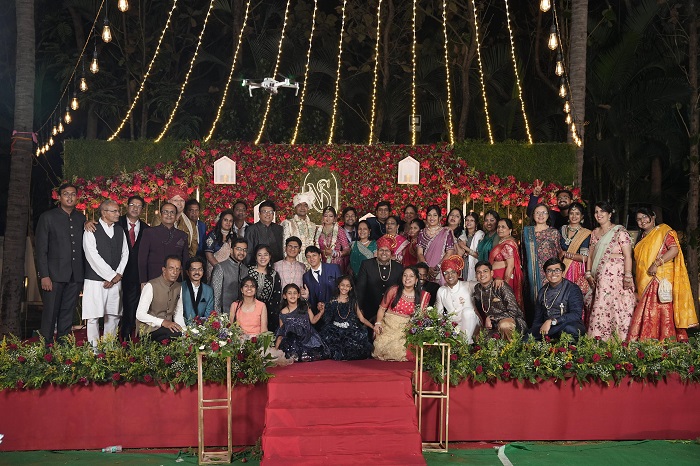
After the personal photos come the group photos. Here, just the closest members of the groom’s family, among whom, proud as peacocks and pleased as punch, yours truly.
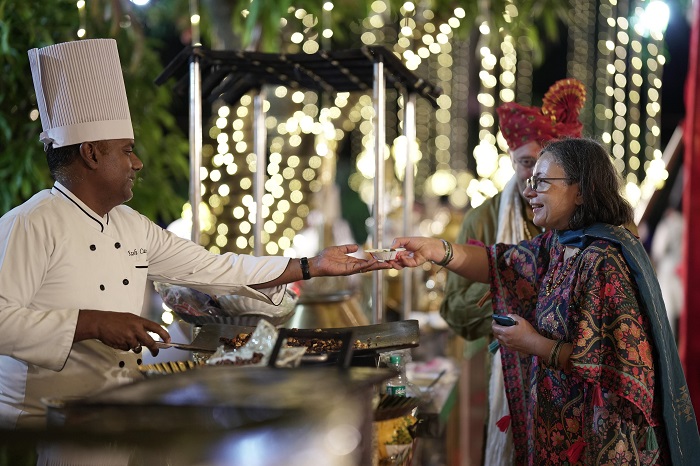
The completely lacto-vegetarian buffet was something out of fairy tales. There must have been some 30 chefs together providing a mouth watering array of made to order and ready cooked foods and drinks. They even roasted mixed spiced nuts on demand!
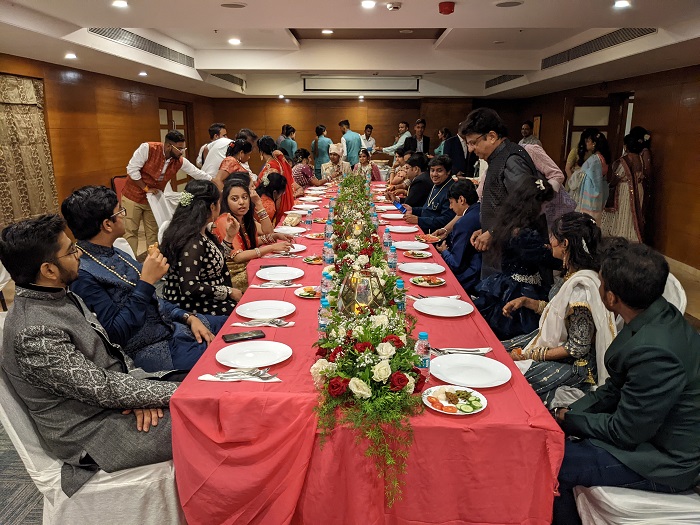
It is therefore not surprising that having tended to their guests’ wellbeing without a moment’s rest, once the reception is over at midnight,, the famished close members of both families gather for a sit down meal together. It is time to rebuild energy as the nuptial blessings are yet to start!
Pheras
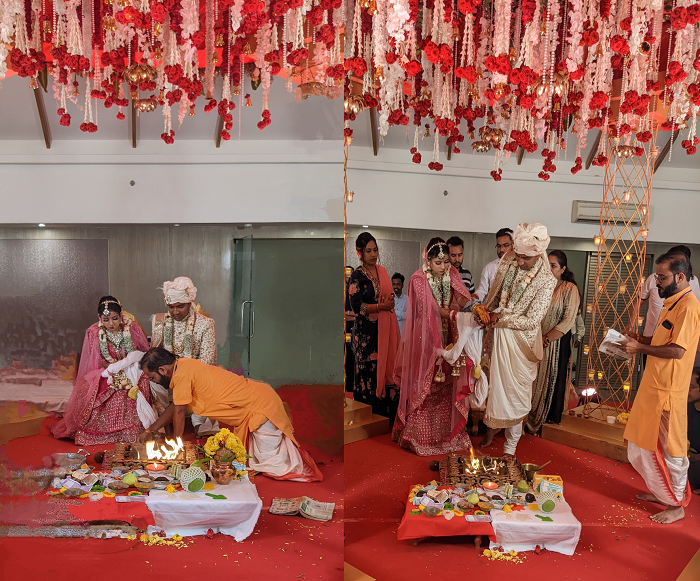
The actual marriage ceremony (Pheras) is a private function taking place into a gorgeously decorated mandap (stage and canopy) at an hour deemed to be auspicious. In this case, the ceremony started at 1am and finished at 4am. The ritual started with prayers, invocations, blessings and offerings in front of an “agni”, a holy fire. It was led by two priests recognisable by their safron costume and their top knots.
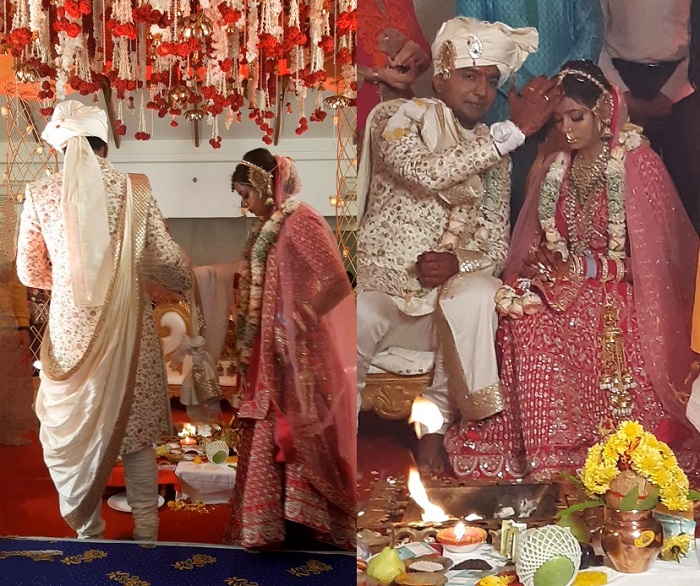
The bride’s ritual scarf is knotted to the groom’s, binding them in matrimony, before they start the Saat Pheras, circling the fire seven times, ushering seven set prayers and vows that the bride and groom make to each other. The groom then applies red powder onto the bride’s hair parting: she is now a fully married woman.
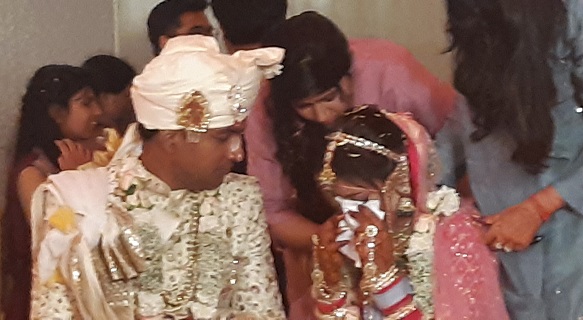
It was very moving to see the bride promptly burst into tears: she knows that she must now say farewell to her parents who live far away, and become fully part of her husband’s family. A small, intimate parting ceremony, just for the bride and her parents followed.
Post Wedding Rituals and Games
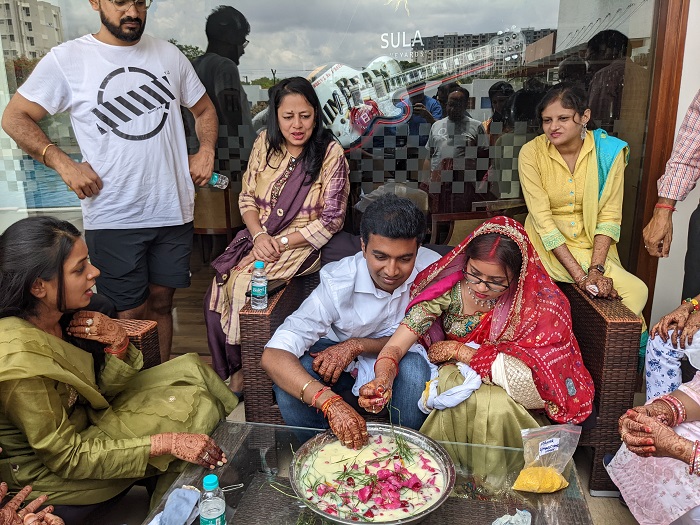
The morning following the wedding, with her childhood family departed, the bride needs to overcome her sorrow and be welcomed into her husband’s family. Crucially, since it is an arranged wedding, the couple must start to get better acquainted. In order to ease them in, under the eyes of the groom’s family, they both take part in a series of traditional post wedding games including this competition to find their wedding rings mixed with other jewellery and grass in a bowl of milk, rose water, rose petals, leaves and turmeric.
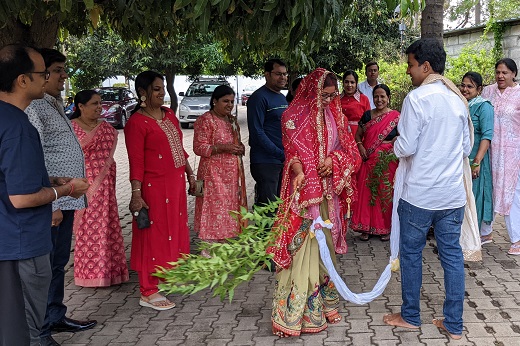
The young couple were gentle with each other in this game to hit each other with tree branches. Many other couples took part and many did it playfully. In contrast, a few longer married couples seemed to vent their frustration, each trying to whack their partners as hard as possible and sometimes succeeding. We decided to opt out of this game.
Next
Returning to the UK in June, followed by Finland and Sweden in July and August.
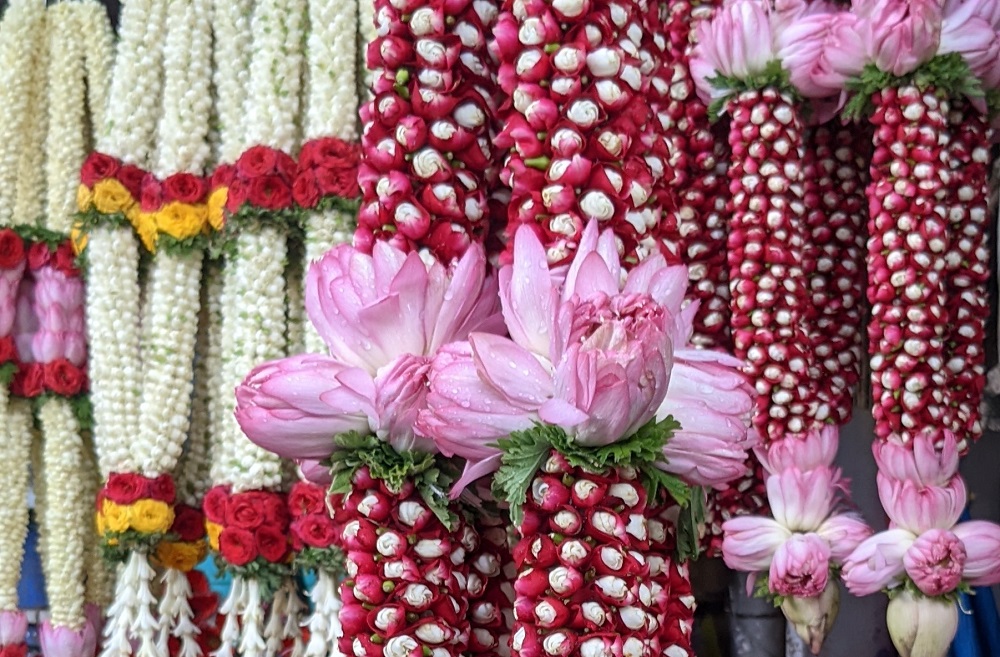
Wow, what a fascinating experience!
Génial : merci pour toutes ces images et ces informations, c’est unique. Les tenues vous vont parfaitement. Love Vivi
That was amazing! So theatrical! It must require great stamina….thus good training for married life to follow. What an experience.
I am forwarding this to Alsa and Dario who got married with minimal fuss on Thursday in Llanelli with just our 2 families . 16 of us; what a contrast…but equally special and beautiful.
Our best wishes for your continuing global adventures
Fiona xx
This is just beyond imagining!! Very beautiful and awe inspiring, but what happens if they end up hating each other? After such a ceremony, and the HUGE cost, you would just have to put up with anything!
Lovely though, that you were welcomed as part of the family. It must have been an amazing experience.
Amazing experience!
Carpe Diem!
Hope to see soon!!
Enjoyed reading all the details of the wedding ceremony and the delightful photos. Hope to see you before you go to Sweden & Finland . I toured in both countries and stayed with a Lapp family in the north.
What stunning photos and looks like you had such an amazing experience.
A unique and fascinating experience thank you for sharing.